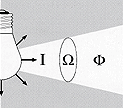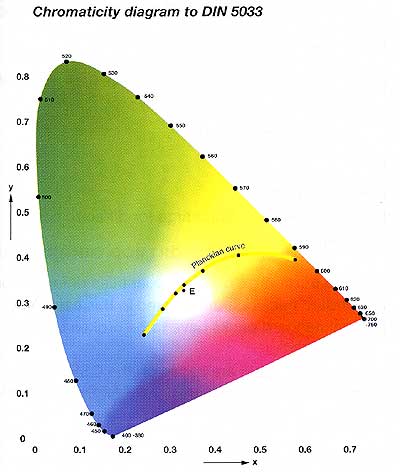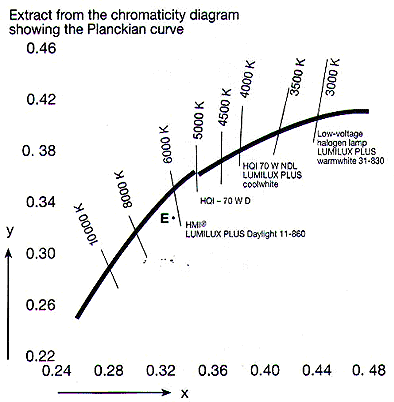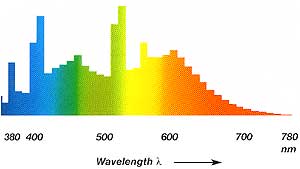As with
any technical or scientific discipline, lighting technology has
its own terminology. Special terms and concepts are used to define
the characteristics of lamps and luminaires and to standardise the
units of measurement. The most important of these are described
here.
Light and radiation |
| |
Light is taken to mean the
electromagnetic radiation that the human eye perceives, in other words
that part of the spectrum that can be seen. This is the radiation
between 360 and 830nm, a tiny fraction of the known spectrum of electromagnetic
radiation. |
Luminous flux £X |
| |
Unit of measurement : lumen (lm).
All the visible radiated power emitted by a light source and perceived
by the eye is called luminous flux £X. |
Luminous
intensity I |
| |
 |
Unit of measurement : can-dela(cd).
Generally speaking, a light source emits its luminous flux £X
in different directions and at different intensities. The visible
radiant intensity in a particular direction is called luminous
intensity I. |
|
Illuminance
E |
| |
 |
Polar diagram
Unit of measurement : lux (lx).
Illuminance E is the ratio between the luminous flux and the
illuminated area. An illuminance of 1 lx occurs when a luminous
flux of 1 lm is evenly distributed over an area of 1 square
metre.
|
|
Luminance L |
| |

Unit of measurement : candelas per square metre (cd/m2)
The luminance L of a light source or an illuminated area is a measure
of its luminous intensity per unit area of illuminated surface.
The most important photometric formulae :
|
| |
I , Luminous intensity[cd] =
Luminous flux in solid angle / Unit solid angle
 [sr] [sr] |
| |
E , Illuminance[lx] = Luminous
flux falling on area[lm] / Illuminated area[¢T] |
| |
= Luminous intensity[cd] / (Distance
in metres2[m] )2 |
| |
L , Luminance[cd/m2]= Luminous
intensity[cd] / Viewed luminous area[m2] |
| |
 Luminous
efficacy[lm/W]= Generated luminous flux[lm] / Electrical power consumed[W] Luminous
efficacy[lm/W]= Generated luminous flux[lm] / Electrical power consumed[W] |
| |

Chromaticity diagram to DIN 5033

Extract from the chromaticity
diagram showing the Planckian curve

Daylight spectrum of a BIOLUX fluorescent lamp.
The radiation is very evenly distributed over the entire visible
range.
|
Luminous efficacy,  |
| |
Unit of measurement : lumens per watt[lm/W].
Luminous efficacy  indicates
the efficency with which the electrical power consumed is converted
into light. indicates
the efficency with which the electrical power consumed is converted
into light. |
Color Temperature |
| |
Unit of measurement ( Kelvin, K )
The colour temperature of a light source is defined in comparison
with a "black body radiator: and plotted on what is known as
the "Planckian curve". The higher the temperature of this
"black body radiator" the greater the blue component in
the spectrum and the smaller the red component. An incandescent lamp
with a warm white light, for example, has a colour temperature of
2700K, whereas a daylight fluorescent lamp has a colour temperature
of 6000K. |
Light color |
| |
The light colour of a lamp can be neatly
defined in terms of colour temperature. There are three main categories
here :
Warm < 3300K
Intermediate 3300 to 5000K
Daylight > 5000K.
Despite having the same light colour, lamps may have very different
colour rendering properties owing to the spectral composition of their
light. |
Color rendering |
| |
As a rule, artificial light should enable
the human eye to perceive colours correctly, as it would in natural
daylight. Obviously, this depends to some extent on the location and
purpose for which light is required. The criterion here is the colour
rendering property of a light source. This is expressed as a "general
colour rendering index"(Ra).
The colour rendering index is a measure
of the correspondence between the colour of an object (its "self-luminous
colour") and its appearance under a reference light source. To
determine the Ra values, eight test colours defined in
accordance with DIN 6169 are illuminated with the reference light
source of the same colour temperature as the source under test and
the test light source. The smaller the discrepancy, between the two
sources, the better the colour rendering property of the lamp being
tested.
A light source with an Ra value of 100 displays all colours
exactly as they appear under the reference light source. The lower
the Ra value, the worse the colours are rendered. |
Luminaire efficiency |
| |
Luminaire efficiency (also known as
light output ratio) is an important criterion in gauging the energy
efficiency of a luminaire. This is the ratio of the luminous flux
emitted by the luminaire to the luminous flux of the lamp (or lamps)
installed in the luminaire.
Information data from Osram. |